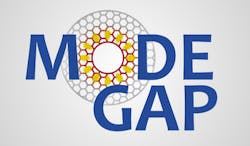MODE-GAP, the European collaborative R&D project, which is investigating space-division multiplexing (SDM; or using a few-mode optical fiber's separate spatial modes to carry separate data channels) to help solve the potential upcoming capacity crunch within the telecommunications networks, has unveiled its latest commercial product: a few-mode fiber erbium-doped amplifier (FM-EDFA).
The product, developed for the transmission experiments in the MODE-GAP project, is the first of its kind to be commercially available on the market, following four years of research and development, according to MODE-GAP.
Developed at the University of Southampton (Southampton, England), the new FM-EDFA will be manufactured by Phoenix Photonics (Surrey, England), a fiber-optic specialist company that joined MODE-GAP in 2011.
Compatible with commercial few-mode fibers
The new product is the first core-pumped amplifier to be made readily available to researchers investigating few-mode fiber mode-division multiplexing (MDM) transmission. It is available in forms that are compatible with the 3- and 6-mode fibers designed by optical-fiber maker OFS (Norcross, GA). Earlier this year, the MODE-GAP project demonstrated record long-haul reach using a full-mode fiber (FMF) technology transmission link, which was enabled through the use of the Southampton FM-EDFAs.
The FM-EDFA is the latest in a range of products that are now commercially available as a result of the project, including few-mode fiber from OFS Fitel, photonic lanterns and fiber-mode converters from Phoenix Photonics, and 2-μm-emitting lasers from Eblana Photonics.
The MODE-GAP project is supported within the European Commission’s 7th Framework Programme. Technologies being developed by MODE-GAP include specialist long-haul transmission fibers, novel rare-earth-doped optical amplifiers, transmitter and receiver components, and data-processing techniques.
For a project overview of MODE-GAP, see http://modegap.eu/?page_id=5

